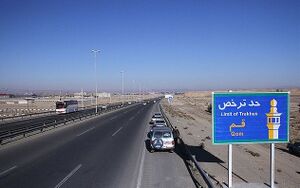Limit of Tarakhkhus

limit of Tarakhkhuṣ (Arabic: حَدُّ التَرَخُّص) is the distance from which a traveler should shorten his prayer and break his fasting. According to hadiths, this is the point at which the call for prayers in the city is not heard or the walls of the city are not visible.
Difference between the Shar'i Distance and the Limit of Tarakhkhus
For a traveler's prayer to be shortened, they should intend to travel 8 Shar'i Farsakh (40 to 45 kilometers). The 8-Farsakh distance is called Shar'i distance.[1]
A traveler can shorten their prayers or break their fasts only when they have traveled a certain distance. This distance is called the limit of Tarakhkhus. The criterion applies to one's arriving in one's hometown or the place where he or she stays for over 10 days.[2] That is, after entering the limit of Tarakhkhus, they should say their prayers completely.
The Distance of Tarakhkhus
According to hadiths from Imams (a), the limit of Tarakhkhus is where the Adhan in the city or the village is not heard or its walls are not visible.[3] Shiite jurists disagree over whether both conditions should be met together or only one of them.[4]
The criterion of the walls (of the city or the village) not being visible refers to usual buildings in a flat ground. Since when big cities were made and Adhan is called through speakers, it is difficult to demarcate the limit of Tarakhkhus. According to some jurists, in big cities the criterion refers to the last walls of the district, not the city.[5]
According to many Shiite jurists, if a person breaks their fast before arriving in the limit of Tarakhkhus, then they should perform the qada' of their fast, and pay expiation.[6]
Notes
References
- Hāshimī Shāhrūdī, Sayyid Maḥmūd. Farhang-i Fiqh muṭābiq-i madhhab-i Ahl al-Bayt. Qom: Muʾassisa-yi Dāʾirat al-Maʿārif-i Fiqh-i Islāmī, 1390 Sh.
- Ḥurr al-ʿĀmilī, Muḥammad b. al-Ḥasan al-. Wasāʾil al-Shīʿa. Muʾassisat Āl al-Bayt li-Iḥyāʾ al-Turāth, 1416 AH.
- Ṭabāṭabāʾī Yazdī, Muḥammad Kāẓim. Al-ʿUrwa al-wuthqā. Qom: Muʾassisat al-Nashr al-Islāmī, 1420 AH.
